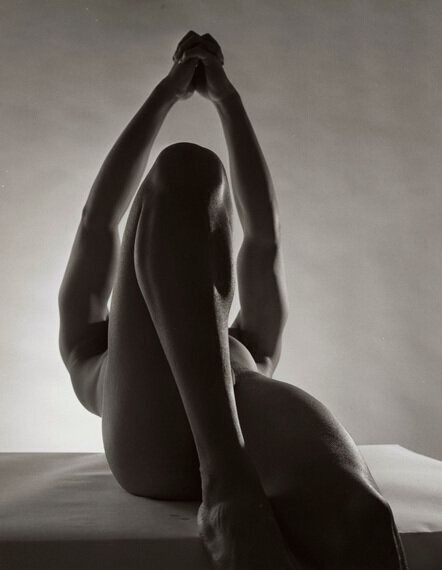
The Horst: Photographer of Style exhibition at the Victoria and Albert Museum is a definitive retrospective on the work of master photographer Horst P. Horst (known simply as Horst), one of the leading photographers of the 20th century.
This exhibition is vast. The V&A has filled room upon room with more than 250 photographs. This could have been overwhelming but Susanna Brown has curated the exhibition superbly as not only have the rooms been themed, but the photos are shown alongside some of Horst's sketchbooks, rare film clips of him at work, as well as haute couture garments from the time from the V&A's permanent collection, and numerous magazine clippings and covers of his work in print.
The result is a fascinating, exciting exhibition that contextualises Horst's work and allows us not just to understand the development of his signature style, but also to witness the profound changes in women, their fashion and their role in society as Horst's career spanned 60 years, and an incredibly formative and changing 60 years too - from the pre-war years to the 1980s.
Horst was a master in the manipulation of light and shadow in creating mood and shaping the human form. But these were developed skills and the early part of the exhibition, from the 1930s when he joined the ranks of Vogue, notes how his early work used to infuriate then-editor Edna Woolman Chase who grew exasperated with the amount of shadow Horst was using in his fashion photography, almost completely obscuring the garments.
But master it, he did, and with extraordinary effect as by the end of the decade he was established as one of the distinguished photographers in fashion and style.

Of course, Horst's rise coincided with the rise of photography in the fashion press, which was quickly replacing illustrations and sketches. But his pre-eminence also coincided with the rise of Hollywood movie stars.
A whole room is dedicated to his portraits of these stars. Joan Crawford, Rita Hayworth, Marlene Dietrich, Bette Davis, Ginger Rogers... The roll-call of those who sat for him is impressive.
To some of these stars he was able to bring something new - his portrait of Marlene Dietrich, in particular, shows more of the real woman rather than the image on screen - but others such as Joan Crawford were impossible to get any kind of concession from. As Horst himself noted, her face was more a mask.
But this exhibition also looks beyond Horst's glamorous fashion photography and his celebrity portraits. Horst's work on male nudes, travel photography and the design in nature are all represented in the display.
The male nudes are superb, and almost all loaned to the exhibition from the private collection of Sir Elton John and David Furnish. Horst's nudes bear all the hallmarks of classical Renaissance art, with its emphasis on the idealised human form and again, using light and shadow to create a sculptural effect.

I also found his natural photography fascinating. Horst published Patterns from Nature in 1946, a book of close-up black and white images of plants, shells and minerals.
Taken in locations across the USA, these photos examine the architecture and form of nature. The shots are so forensic, so close-up that the subjects are taken out of their natural setting - an examination of their beauty through design rather than their place in the natural world.
There are also some surprises.
Horst was intrigued by surrealism and worked with Salvador Dali on his costumes for the Dream of Venus Pavilion, which was shown at the New York World Fair in 1939. His design with Dali fuses the erotic and sensual imagery with the surreal and the results are fascinating.
But, of course, this exhibition wouldn't be complete without the Mainbocher Corset, one of the most famous fashion photos ever.

Here, the V&A has displayed a couple of the shots taken in this sitting, showing again how Horst played with the balance of shadow and light until he got the image he was after.
The photos are also shown alongside some of Horst's preliminary sketches for the shot. The sketches show plans for a plant to be included in the frame but this was obviously discarded at some point in the process.
As you weave through the galleries, the stylised black and white photography is atmospheric and completely absorbing. But then suddenly the exhibition hits you with a bright, vibrant burst of colour as Horst's large vintage prints are hung together in a white-walled room. The effect is wonderful and the setting really brings out the impact of this sudden rush of colour.
Horst's colour photographs are rarely exhibited because few of the vintage prints are still around but shown together, alongside a tableau of over 90 Vogue magazine covers from across the decades, the effect is wonderful.
This exhibition is superb, and not just interesting for its content but also as an illuminating overview of the career of one of the most influential fashion portrait photographers of the 20th century, and a study on how that craft was honed and polished over the years.
Victoria & Albert Museum, London to January 4, 2015
Admission £8 (concessions available)
Image credits:
1. Summer Fashions, American Vogue cover, : 15 May 1941 © Condé Nast / Horst Estate
2. Installation image of Horst - Photographer of Style © Victoria and Albert Museum, London
3. Male Nude, 1952 © Condé Nast / Horst Estate
4. Corset by Detolle for Mainbocher, 1939 © Condé Nast / Horst Estate